Professor Brian Morris
- Professor of Molecular Neurobiology (School of Psychology & Neuroscience)
telephone:
01413305361
email:
Brian.Morris@glasgow.ac.uk
R306 Level 3, West Medical Building, Glasgow G12 8QQ
Research interests
Schizophrenia - characterisation of neurobiological dysfunction, identification of genomic abnormalities, identification of novel drug candidates. Neuronal plasticity - role of protein signalling complexes, mRNA translation, (including dendritic mRNA), and gene transcription (including transcription factors) in sustaining late phase of long-term potentiation.
Professor Brian Morris is a neuroscientist, whose abilities helped attract YRING - a highly successful target and drug discovery Institute based within the Universities of Strathclyde and Glasgow, and funded by Mitsubishi Pharma Corporation of Japan - to Glasgow. His research interests are focussed on the causes of psychiatric disease, and the mechanisms of synaptic plasticity in the brain. For 10 years he was Co-Director of YRING. He is now a Co-Director of the Psychiatric Research Institute of Neuroscience in Glasgow (PsyRING) along with Professor Judith Pratt of the University of Strathclyde and Professor Robert Hunter of NHS, Greater Glasgow and Clyde.
Projects:
Genetic and genomic analysis of neuronal function in psychiatric diseases such as schizophrenia, and neurodegenerative diseases such as Parkinsonism and Alzheimer's disease; molecular and functional analysis of the mechanisms of synaptic plasticity in the CNS, in relation to learning and memory formation; investigation of the molecular mechanisms linking alterations in the neurochemical environment to sustained changes in neuronal gene expression.
The research uses a variety of cultured cells to study long-term changes in neuronal activity, studying this "plasticity" in terms of :
- the cellular mechanisms (what extracellular and intracellular signals induce plasticity ?)
- the functional consequences (what is the effect on cell function of a particular change in cellular biochemistry ?)
The studies are centred on understanding plasticity in three brain regions:
- the cerebral cortex (subtle pathology and disconnectivity linked to psychiatric diseases such as schizophrenia)
- the hippocampus (long-term changes are linked to mechanisms of learning and memory, and also to diseases such as Alzheimer's disease and epilepsy)
- the basal ganglia (long-term changes are linked to motor control and also to diseases such as Parkinson's disease)
The experimental techniques used are designed to study the proteins and mRNAs expressed by the cultured cells, and to monitor the effect of altered expression of identified genes, for example by neuronal transfection.
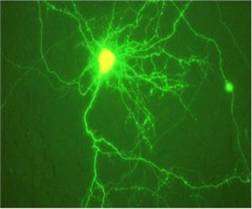
The image shows a cultured hippocampal neurone transfected with a green fluorescent protein vector.
Neuronal function in psychiatric and neurodegenerative disease
Psychiatric and neurodegenerative diseases result from altered function of neurones and their connections in specific brain areas. For example, Parkinson's disease results from a loss of the dopamine-secreting cells in the substantia nigra at the base of the brain, while schizophrenia results from compromised function of a population of interconnected cells in the prefrontal cortex, temporal cortex and thalamus. The dysfunction of these cells is caused by a poorly understood combination of genetic and environmental influences.
In Parkinson's disease, the loss of the dopamine cells leads to abnormal activity in a network of brain regions known as the basal ganglia. Since this network controls aspects of movement, patients experience a variety of symptoms linked to loss of movement control. While drugs such as L-DOPA are effective, particularly in the early stages of the disease, unpleasant side-effects, combined with loss of efficacy in many cases, makes the search for novel treatments of great urgency.
In schizophrenia, impaired function of cortico-thalamic networks leads to "positive" symptoms such as hallucinations and delusions, "negative" symptoms such as depression, social withdrawal and inability to experience pleasure, along with deficits in cognitive processes. This impaired function is centred on the prefrontal cortex and associated areas. Highly localised damage to these areas is sufficient to produce the symptoms of the disease. Existing drugs deal effectively with the positive symptoms, but show little activity against the negative symptoms and cognitive deficits, and cause a number of unpleasant side-effects. Novel drugs with improved efficacy and reduced side-effect profiles are urgently required.
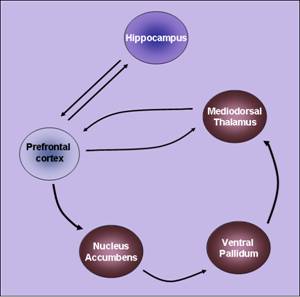
The research adopts a multidisciplinary approach to understanding the causes of these diseases, and hence identifying potential new and improved treatment strategies. Genetic, genomic, molecular, cellular and systems level techniques are employed.
Mechanisms of synaptic plasticity in the CNS
Neurones can alter aspects of their biochemical and morphological character in response to changes in their local environment or their level of activity. This plasticity allows them to adapt and survive in altered conditions, or assume a changed functional role. Three distinct temporal components of neuronal plasticity can usually be idebtified - a rapid phase, apparent within a few milliseconds and lasting for an hour or so, an intermediate phase, lasting for 2-3 hours, and a late phase lasting from 2-3 hours up to many weeks. These distinct temporal phases are sustained by entirely different cellular mechanisms.
Rapid phase:
In many cases, the trigger for the induction of synaptic plasticity is activation of the N-methyl-D-Aspartate (NMDA) class of ionotropic glutamate receptor. This is true for one of the best studies models of synaptic plasticity - long-term potentiation (LTP) in the hippocampus. In LTP, brief high-frequency stimulation of the neuronal connections leads to a long-lasting enhancement of the efficiency of synaptic transmission. This is believed to be related to the mechanisms of learning and memory.

Calcium entry through the stimulated NMDA receptor leads to activation of signalling intermediates such as protein kinase C, ERKs (extracellular-signal-regulated kinases) and Ca2+/calmodulin-dependent kinases. Many of these signalling events are compartmentalised within the dendritic spines that are the site of the excitatory input. However, the ways in which these signalling pathways interact, and how they exert their downstream effects, are not clear.
We have discovered that a small protein known as RhoB - a member of a large family of molecules that act as molecular switches, gating signalling cascades, particularly in relation to cancer - is activated during synaptic plasticity, and plays a key role in co-ordinating many of the lasting effects on the neurone. In addition, we have obtained new insight into the role of ERK, and its downstream effectors such as Msk1, in plasticity in the CNS.
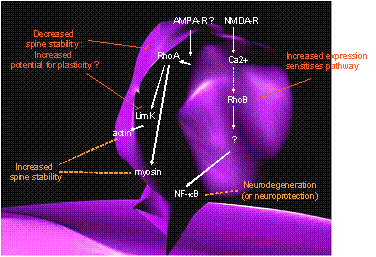
Intermediate phase
Permanent memory formation is known to require the synthesis of new proteins in brain regions such as the hippocampus. Long-term potentiation (LTP) of synaptic transmission between hippocampal neurones represents a widely used cellular model of memory formation, and this LTP also requires protein synthesis. LTP is highly restricted to the synapse - the region of the cell where the incoming fibres make contact, yet protein synthesis takes place a relatively long distance away in the body of the cell. Hence it is not clear how the proteins that are newly synthesised in response to the activity in an incoming nerve fibre find their way specifically to the activated synapse, somewhere out on the branching network of neuronal dendrites.
One possibility is that the neuronal cell takes advantage of the presence of a few mRNAs out in the dendrites, far away from the cell body, but in the vicinity of the synapses (an enlarged portion of the dendrite is shown schematically here). We have recently shown that synaptic activity can increase the stability of these dendritic mRNAs in cultured neurones, making the mRNA levels rise in the dendrite, and hence increase synthesis of the corresponding proteins in a highly localised part of the cell in the region of the stimulation. This provides an elegant mechanism to link highly discrete presynaptic fibre activity to highly localised postsynaptic protein synthesis.
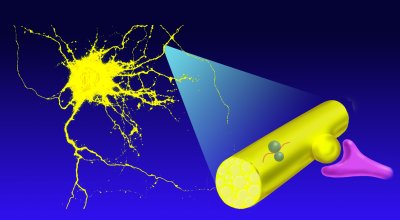
(Thanks to Ian Ramsden for artwork)
Late phase
The late phases of LTP are dependent on gene transcription and protein synthesis. A number of transcription factors - proteins that switch on or off specific genes in the genome - are activated by the above signalling pathways. Induction of plasticity at the activated synapse alters transcription factor activity in the cell nucleus. Two transcription factors with a particularly prominent role in synaptic plasticity and in learning and memory are CREB and zif268. Both mediate altered gene transcription in response to NMDA receptor stimulation. Our recent work has identified the target genes of zif268 in neurones - likely to be the genes that sustain the altered neuronal function in the long-term.
Surprisingly, these include a prominent set of genes encoding components of the proteasome - the cellular "waste disposal" system. This focusses attention on the possible role of targetted protein degradation in sustaining synaptic plasticity.
However, how, and to what extent, the products of the altered transcriptional activity are transported back to the activated synapse, is not clear.
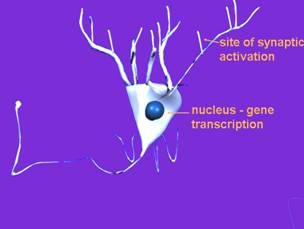
Grants
Grants and Awards listed are those received whilst working with the University of Glasgow.
- SERVIERLAB (Nr 141704/DM)
Servier (FR)
2019 - 2019
- RhoB and the role of neuronal plasticity
Biotechnology and Biological Sciences Research Council
2005 - 2009
- Genetic control of learning behaviour - characterisation of downstream genes regulated by zif/268
Biotechnology and Biological Sciences Research Council
2004 - 2005
Supervision
Supervised Postgraduate Students
- Klaudia Jasionowska (Postgraduate)
- Yaprak Karabalci (Postgraduate)
- Liang Yue (Postgraduate)
Research Assistant
- Ashleigh Willis (Affiliate)
Additional information
Grant Advisory Board
- 2015 - present: European Commission - H2020 Panel
- 1999 - 2001: European Commission Framework V - Neurosciences Panel
Invited International Presentations
- 2014: Nice, France - Session Chair and Symposium Speaker - European College of Neuropsychopharmacology Workshop
- 2009: Princeton, NJ, USA, - Invited participant - TMRC Grand Challenges Workshop: Psychosis and Cognition, Pfizer Laboratories
- 2008: Osaka, Japan - Symposium Speaker - World Congress of Psychiatric Genetics
- 2008: Osaka, Japan - Invited Speaker - Scottish Enterprise Trade Mission, British Consulate
Professional Learned Society
- 1997 - present: Society for Neuroscience - Member
- 1993 - present: European Neuroscience Association - Member
- 1985 - present: British Neuroscience Association - Member
- 1985 - present: British Pharmacological Society - Member
Research Fellowship
- 1990 - 1995: Wellcome Trust University Award



